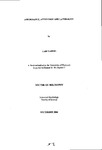AFFORDANCE, ATTENTION AND LATERALITY
| dc.contributor.author | VAINIO, LARI | |
| dc.contributor.other | Faculty of Science and Engineering | en_US |
| dc.date.accessioned | 2013-09-24T09:58:41Z | |
| dc.date.available | 2013-09-24T09:58:41Z | |
| dc.date.issued | 2004 | |
| dc.identifier | NOT AVAILABLE | en_US |
| dc.identifier.uri | http://hdl.handle.net/10026.1/1915 | |
| dc.description.abstract |
This thesis examines object-guided actions. Recently, micro-affordance effects have shown that a visual object affords actions automatically. These effects are observed when the grasp type (precision and power grasp) is facilitated by size (small and large) of the categorized object (the object-size effect), or when right or left hand responses are facilitated by object orientation (the object-orientation effect). It has been shown elsewhere that attentional mechanisms have a vital role in visually guided movements. In addition, visually guided movements have associated with hemispheric lateralization. Thus, the central focus of the thesis was the role of different components of attention (location-based-, object-based-, endogenous-, exogenous-, focused attention) in micro-affordance effects, and the hemispheric lateralisation of these effects. Using the stimulus-response compatibility (SRC) paradigm, a set of nine experiments (six that employed the object-orientation effect and three that employed the object-size effect) investigated aspects of attention and lateralization in visuomotor integration. A participant performed bi-manual keypresses or precision/power grip responses according to the identity of a target that was displayed over the task-irrelevant prime. Size or orientation properties of the prime object were manipulated, and outcome of interest was how those object properties effected corresponding or non-corresponding responses. The data showed that both micro-affordance effects could be observed when the allocation of endogenous attention to the prime is minimal or absent. However, the generation of both effects were observed to need resources of focused attention. In addition, the data supported the view that the object-orientation effect is generated by the orientation of the entire object and not by a shift of attention to the object’s handle location. Finally, manual asymmetries in these effects suggested that visually guided precision grips are computed predominantly in the left hemisphere whereas power grips are computed in the right hemisphere. | en_US |
| dc.language.iso | en | en_US |
| dc.publisher | University of Plymouth | en_US |
| dc.title | AFFORDANCE, ATTENTION AND LATERALITY | en_US |
| dc.type | Thesis | |
| plymouth.version | Full version | en_US |
| dc.identifier.doi | http://dx.doi.org/10.24382/1579 |
Files in this item
This item appears in the following Collection(s)
-
01 Research Theses Main Collection
Research Theses Main


